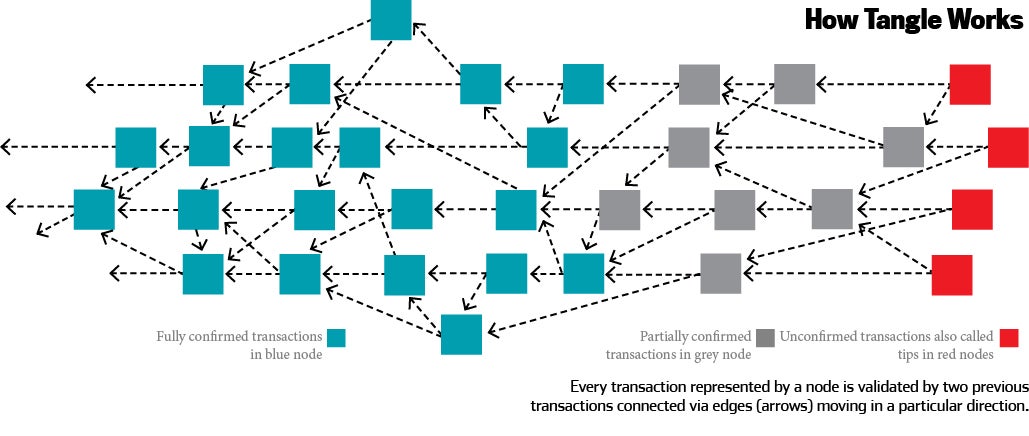Tangle Might Untangle the Blockages in Blockchain Scale-up Since 2008, everyone has been frantically engaged in the exploration of blockchain-based applications, beyond cryptocurrencies to solve real-world problems. Enroute to their discoveries, however, are some twists that need to be untangled.
By Sandeep Soni
Opinions expressed by Entrepreneur contributors are their own.
You're reading Entrepreneur India, an international franchise of Entrepreneur Media.

The immutable nature of blockchain has led to a never seen before transparency and security of data sharing that has made the distributed ledger technology and cryptocurrencies increasingly mainstream. As per cryptocurrency wallet Blockchain.info, the number of daily bitcoin transactions grew from one in January 2009 to 4.9 lakh in December 2017. The most promising use case for blockchain, other than cryptocurrencies, has been internet of things (IoT) to record the huge data exchange between two smart devices.
Finding Scale
There is a limit to the Bitcoin block size – 1 mb as of now, that reportedly can manage only around seven transactions per second - quite slow. This transaction speed is non-existent when compared to VISA which processes around 2,000 transactions per day on an average and PayPal's around 200. As big data usage grows, blockchain's ability to support large data sets a.k.a scalability comes into question.
"In Bitcoin blockchain, you must store all the history of transactions from the beginning. So far, it is not so dramatic because the size of it is manageable. Going ahead, if the transaction numbers grow to VISA, Mastercard etc., in size, then the block will blow up," says Brazil-based Serguei Popov, Co-creator, Tangle - another ledger technology, and Co-founder, IOTA – Tangle based cryptocurrency.
Tangle is a block-less technology created around 2014 that serves as an alternative to the blockchain's scalability problem. It is based on Directed Acyclic Graph (DAG) that gives it a tangle shape, as the transactions are linked to each other via nodes. These transactions are recorded in multiple layers in a node, further connected to other nodes via its edges.
Since there are no blocks to be mined unlike in blockchain, the transactions are verified parallel which saves time and makes the process faster. "Tangle removes the need for mining and proof-of-work, unlike in blockchain network. The validation is done by distributed validators, which are the known parties in the network. If the validator submits the transaction which is incorrect, it will not be accepted by rest of the validators," says Raj Chowdhury, Managing Director, HashCash Consultants. The company helps businesses in cross-border payments and asset movement using blockchain. The former head of innovation at ICICI Bank, Chowdhury carried out trade finance and remittance using blockchain technology in 2016 for the bank - first time in India.
Faster Validation
While it takes around 10 minutes to mine a block in blockchain, in Tangle to record a new transaction, the user has to approve previous two transactions in the network instead of waiting for the relevant parties in the blockchain network to approve it. For example, in blockchain, when A sends bitcoin to B, the transaction is validated by miners (people in the network) with consensus. The block is then added to the chain. In Tangle, since there are no blocks, hence there is no mining. A is presented with two previous transactions, which he/she needs to validate. This adds his/her transaction to the network, which similarly would be validated by the next user. This dramatically reduces the time taken in the transaction validation. Currently, IOTA can record 500-800 transactions per second, as per reports.
"Theoretically, IOTA Tangle can have as many transactions as it wants because every new transaction verifies two existing ones in the network. Hence, it seems scalable and faster than bitcoin or ethereum blockchain, which is restricted by a number of transactions. However, it is too early to conclude, since Tangle is a very new concept," says Vishal Nigam, Chairman and Founding Member, Indian Blockchain Council.
The more transactions Tangle has, the more verifiers it gets. Hence, there is no limit to the number of transactions happening in a specific time frame.

Free Service
Blockchain miners to validate the transaction are given a fee. However, since in Tangle IOTA, the consensus on the transaction's validity doesn't involve miners, it is free from any transaction fee. The charges depend on the size of the transaction, the volume of transactions in a network and how soon you want the transaction to be confirmed. While, currently, it is around $1, however, in December last year, it went up by as much as $40. "For micropayments, the transaction fee is very high. For example, if you are sending $100 for which the fee is $40, then that's not feasible," adds Nigam. Currently, Tangle exits only through IOTA in India. "It has to do the same what Bitcoin and Ethereum are doing - building the ecosystem around the technology in India. People here know about IOTA as a coin to buy and sell," claims Nigam.
Despite the advantages over blockchain, how Tangle or Hashgraph (another DAG-based distributed ledger technology that is claimed to be more superior to blockchain) performs, it would take another three-four years to understand. "I don't think there will be a single crypto system which will dominate all. There will be several of them for different purposes, for example, bitcoin for store of value, and IOTA for IoT. Traditional blockchain approach, however, wouldn't die," concludes Popov.
(This article was first published in the May issue of Entrepreneur Magazine. To subscribe, click here)










